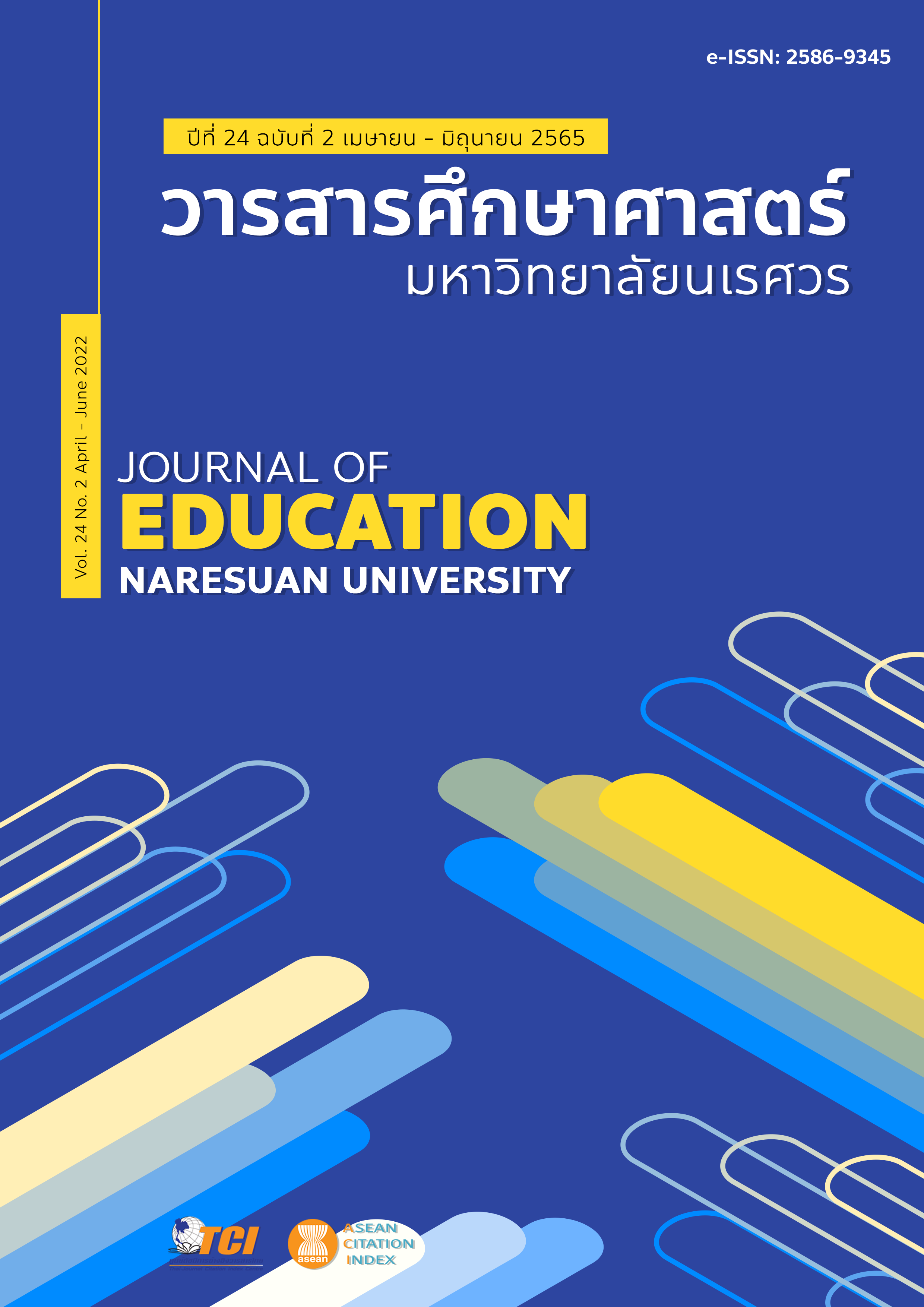นวัตกรรมการพัฒนาหลักสูตรโรงเรียนประถมศึกษาตามแนวคิดการประเมินแบบร่วมมือและเป้าหมายของสะเต็มศึกษา CURRICULUM DEVELOPMENT INNOVATION OF PRIMARY SCHOOL BASED ON THE CONCEPT OF COLLABORATIVE EVALUATION AND STEM EDUCATION GOALS
Main Article Content
บทคัดย่อ
การวิจัยครั้งนี้มีวัตถุประสงค์เพื่อ 1) ศึกษาความต้องการจำเป็นของการพัฒนาหลักสูตรโรงเรียนประถมศึกษาตามแนวคิดการประเมินแบบร่วมมือและเป้าหมายของสะเต็มศึกษา 2) ศึกษาแนวปฏิบัติที่ดีของการพัฒนาหลักสูตรโรงเรียนประถมศึกษาตามแนวคิดการประเมินแบบร่วมมือและเป้าหมายของสะเต็มศึกษา และ 3) พัฒนานวัตกรรมการพัฒนาหลักสูตรโรงเรียนประถมศึกษาตามแนวคิดการประเมินแบบร่วมมือและเป้าหมายของสะเต็มศึกษา ประชากร คือ โรงเรียนเครือข่ายสะเต็มศึกษาที่เปิดสอนระดับประถมศึกษา จำนวน 26 โรงเรียน โดยเก็บข้อมูลจากประชากรทั้งหมด กลุ่มผู้ให้ข้อมูลประกอบด้วย 1) ผู้มีส่วนได้ส่วนเสียของทั้ง 26 โรงเรียน ได้แก่ ผู้บริหารสถานศึกษา 26 คน ครู 52 คน ผู้ปกครอง 52 คน และผู้แทนชุมชน 78 คน รวมทั้งสิ้น 208 คน 2) ผู้มีส่วนได้ส่วนเสียของโรงเรียนที่มีแนวปฏิบัติที่ดี จำนวน 5 โรงเรียน ได้แก่ ผู้บริหารสถานศึกษา 5 คน ครู 5 คน ผู้ปกครอง 5 คน และผู้แทนชุมชน 15 คน รวมทั้งสิ้น 30 คน และ 3) ผู้ทรงคุณวุฒิ ด้านสะเต็ม 2 คน ด้านการประเมินแบบร่วมมือ 1 คน ด้านการพัฒนานวัตกรรม 1 คน และด้านการบริหารสถานศึกษา 5 คน รวมทั้งสิ้น 9 คน เครื่องมือที่ใช้ในการวิจัยประกอบด้วย แบบสอบถาม แบบสัมภาษณ์ และแบบประเมิน สถิติที่ใช้ในการวิเคราะห์ข้อมูล ได้แก่ ความถี่ ค่าเฉลี่ย ส่วนเบี่ยงเบนมาตรฐาน การวิเคราะห์เนื้อหาจับประเด็น และความต้องการจำเป็นแบบปรับปรุง ผลการวิจัย พบว่า
1. ความต้องการจำเป็นของการพัฒนาหลักสูตรโรงเรียนประถมศึกษาตามแนวคิดการประเมินแบบร่วมมือและเป้าหมายของสะเต็มศึกษาที่มากที่สุด คือ การพัฒนาหลักสูตรโดยการเก็บรวบรวมข้อมูลจากผู้มีส่วนได้ส่วนเสียทุกภาคส่วนเกี่ยวกับการบูรณาการความรู้ไปใช้ในการแก้ปัญหาชีวิตประจำวัน (PNImodified = .111)
2. แนวปฏิบัติที่ดีของการพัฒนาหลักสูตรโรงเรียนประถมศึกษาตามแนวคิดการประเมินแบบร่วมมือและเป้าหมายของสะเต็มศึกษา ประกอบด้วย 4 แนวปฏิบัติ ประกอบด้วย การออกแบบหลักสูตรที่ยึดโยงกับโลกแห่งความเป็นจริง การออกแบบหลักสูตรที่บูรณาการข้ามหน่วยและข้ามกลุ่มสาระ การออกแบบหลักสูตรที่บูรณาการความรู้ด้านเทคโนโลยี และการออกแบบหลักสูตรที่ยืดหยุ่นตามระดับความสามารถในการเรียนรู้ของผู้เรียน
3. นวัตกรรมการพัฒนาหลักสูตรโรงเรียนประถมศึกษาตามแนวคิดการประเมินแบบร่วมมือและเป้าหมายของสะเต็มศึกษา ประกอบด้วย จุดมุ่งหมายของหลักสูตร หลักการของหลักสูตร สมรรถนะสำคัญของผู้เรียน และแผนผังการพัฒนาหลักสูตร
Article Details

This work is licensed under a Creative Commons Attribution-NonCommercial-NoDerivatives 4.0 International License.
เจ้าของบทความมิได้คัดลอก หรือละเมิดลิขสิทธิ์ของผู้ใด หากเกิดการละเมิดลิขสิทธิ์ ไม่ว่าวิธีใด หรือการฟ้องร้องไม่ว่ากรณีใด ๆ ที่อาจเกิดขึ้นได้ กองบรรณาธิการวารสารศึกษาศาสตร์ ไม่มีส่วนเกี่ยวข้องทั้งสิ้น ให้เป็นสิทธิ์ของเจ้าของบทความที่จะดำเนินการ
References
Aiumdee, S., Chaiyagij, M., Ngrorangsri, K., & Chanchalor, S. (2013). The development of the participative education networks system under the Management of Primary Educational Service Area Offices. Journal of Education Naresuan University, 15(Special Edition), 216-224. [in Thai]
Asawapoom, A. (2008). Modern education management: concepts, theory, and practice. Ubon Ratchathani: Ubonkit Offset Press. [in Thai]
Bloom, B. S., Krathwohl, D. R., & Masia, B. B. (1984). Bloom taxonomy of educational objectives. Allyn and Bacon: Pearson Education.
Boonprasert, P., & Jantarapanya, P. (2018). Parental participation of private kindergarten students: analysis of expectations and process creation for parental participation, case study of Daroonnimit Kindergarten. EAU Heritage Journal Social Science and Humanities, 12(1), 125-136. [in Thai]
Burke, B. (1998). Evaluating for a change: Reflections on participatory methodology. New Directions for Evaluation, 80, 43-56.
Chaowachote, S., & Kessadayurat, C. (2016). Managing Relationship in a Nursery School. Journal of Business, Economics and Communications, 11(1), 69-82. [in Thai]
Deal, T. E., & Peterson, K. D. (2007). Eight roles of symbolic leaders. The Jossey-Bass Reader on Educational Leadership, 197-209.
Fetterman, D. M., & Wandersman, A. (2005). Empowerment evaluation principles in practice. New York: Guilford Publications.
Guba, E. G., & Lincoln, Y. S. (1989). Fourth generation evaluation. Newbury Park, Calif: Sage Publications
Hong, O. (2017). STEAM education in Korea: Current policies and future directions. Science and Technology Trends Policy Trajectories and Initiatives in STEM Education, 8(2), 92-102.
Johnson, C. C., Burton, P., Moore, E., Tamara, J. (2015). STEM road map: A framework for integrated STEM education. New York, NY: Routledge.
Klomim, K. (2019). STEM education curriculum development. Phitsanulok: Ratanasuwan Printing. [in Thai]
Lewkowicz, J. A., & Nunan, D. (1999). The limits of collaborative evaluation. Tesol Quarterly, 33(4), 681-700.
Moore, T. J., Guzey, S. S., & Brown, A. (2014). Greenhouse design to increase habitable land: An engineering unit. Science Scope, 37(7), 51-57.
National Research Council. (2011). Successful K-12 STEM education: Identifying effective approaches in science, technology, engineering, and mathematics: National Academies Press.
National Science Board. (2007). A national action plan for addressing the critical needs of the US science, technology, engineering, and mathematics education system. National Science Foundation.
Office of the Education Council. (2016). Policy proposals for promoting STEM education in Thailand (Research report). Bangkok: Prigwarn Graphic. [in Thai]
Office of the Education Council. (2018). National education standards B.E. 2561. Bangkok: Office of the Education Council. [in Thai]
O'Sullivan, R. G. (2004). Practicing evaluation: A collaborative approach. Thousand Oaks, CA: SAGE.
Vasquez, J. A., Sneider, C. I., & Comer, M. W. (2013). STEM lesson essentials, grades 3-8: Integrating science, technology, engineering, and mathematics. Portsmouth, NH: Heinemann.
Young, J., Shaxson, L., Jones, H., Hearn, S., Datta, A., & Cassidy, C. (2014). Rapid outcome mapping approach: A guide to policy engagement and influence. London, UK: Overseas Development Institute (ODI).

